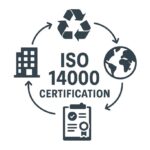What is the Environmental Product Declaration (EPD)?
An Environmental Product Declaration (EPD) is a document that helps firms explain the environmental performance of their goods and may satisfy net zero environmental disclosure requirements. EPDs originated as volunteer environmental impact demonstrations.
EPDs are now governed by globally recognized standards and readily integrated into construction processes, notably for sustainable building certifications such as LEED, BREEAM, and DGNB. EPDs, based on Life Cycle Assessment (LCA), measure the environmental consequences of items from “cradle to grave.” EPDs provide purchasers with detailed information about a product’s ecological implications, such as its carbon footprint, and allow them to choose products based on environmental performance. EPDs, as an independently validated documents, may help marketing communication tools and provide businesses with a competitive advantage in green public procurement.
EPDs are becoming more critical in the construction industry for building design and material selection — but they can do so much more! They may also serve as the foundation for a company’s decarbonization plan.
In suammary: EPD is a document that discloses the environmental performance or impact of any product or substance during its lifespan transparently. EPDs help to reduce carbon emissions by allowing users to assess the effects of various materials and products to choose the most sustainable alternative. EPDs are documents that disclose in an open, transparent manner the environmental performance or impact of a product or substance during its lifetime.
An Example from the Construction Sector
By comparing the environmental effects of various products and materials, EPDs in the construction sector help reduce carbon emissions.
Civil engineers, architects, engineers, and designers can select the best environmentally friendly solution. Manufacturers may optimize the environmental effect of their goods and sell their carbon transparency.
EPDs Validities
Usually, EPDs are valid for 5 years and are created by criteria. Creating construction EPDs involves the application of ISO 14040/14044, ISO 14025, EN 15804, or ISO 21930 standards. Certification schemes such as LEED, BREEAM, and others, EPDs contribute to achieving EPD and LCA credits.
The Framework for Developing an EPD
Product Category Rules (PCR) are used to define products in EPDs. A third-party panel validates PCRs, which are specific norms and regulations. Validating a Life Cycle Inventory (LCI) and sourcing it from credible sources (such as manufacturers) is necessary for the LCA. An LCA specialist uses various assessment techniques and software to carry out a Life Cycle Impact Assessment (LCIA). The EPD is then produced as a document or report following verification assessments.
The Advantages of EPDs for Businesses
EPDs in building and industry are optional. Due to growing environmental awareness, however, they rapidly increase. In both the public and private sectors, EPDs are becoming increasingly important. Developing or using EPDs has many advantages, such as:
Businesses may benefit from EPDs by defining their baseline emissions and identifying hotspots across the value chain. EPDs may construct an effective decarbonization plan in today’s changing financial and regulatory environment. Corporate decarbonization strategies can be built on EPDs, enabling firms to develop better products and more environmentally friendly operations. Your product or project will be differentiated if you develop an EPD or use one
EPDs are also recognized by LEED and BREEAM, among other market-based certifications. LCA credits are relatively simple and cost-effective compared to additional credits.
The Importance of Third-party Verification Can Be Summarized
The unbiased, harmonized, and comparable data provided by EPDs is primarily due to third-party verification. ISO 14025, a global standard that specifies EPDs, includes it as a critical component. Suppose a third-party has not verified your EPD. In that case, it will not be recognized by many certification schemes, legislation, or procurement requirements.
Increasing demand for EPDs makes it easier for firms to sell labels that meet the EPD definition but are not verified by a third-party. Buyers should exercise caution. If you do, you may find skipping this step in the short term appealing. Still, your EPD investment may prove largely ineffective eventually. Evaluate the product’s life cycle: the LCA must follow the product Life Cycle Assessment guidelines.
Your EPD should include a background report (called an LCA report in the US) as part of its public release. Further information is provided on the LCA methodology, assumptions, techniques used to enable third-party verification, and the standards you followed.
Independent third-party validators must validate EPDs before they can be published. Step 4 – The third-party verification process ensures accuracy, consistency, and conformity with the PCR standards.
How Does Third-party Verification Affect Business? The Following Is a List.
Your EPD is now ready to be published in the public domain after an independent third-party has confirmed it. Here, the program operator will process, register, and print the EPD document on behalf of the organization.
The Importance of Third-party Verification Can Be Summarized
The unbiased, harmonized, and comparable data provided by EPDs is primarily due to third-party verification. ISO 14025, a global standard that specifies EPDs, includes it as a critical component. Suppose a third-party has not verified your EPD. In that case, it will not be recognized by many certification schemes, legislation, or procurement requirements.
Increasing demand for EPDs makes it easier for firms to sell labels that meet the EPD definition but are not verified by a third-party. Buyers should exercise caution. If you do, you may find skipping this step in the short-term appealing. Still, your EPD investment may prove largely ineffective eventually.
How EPDs Help the Decarbonization Strategy
By generating a complete carbon accounting, EPDs can help organizations better understand their carbon footprint, making them an appropriate starting point for a decarbonization strategy. An organization’s direct and indirect greenhouse gas emissions are collected, quantified, and monitored through carbon accounting (GHG accounting). There are three categories of greenhouse gas emissions outlined in the Greenhouse Gas Protocol.
Scope 1 concerns direct emissions from the company’s operations. In Scope 2, indirect emissions result from purchasing energy, such as electricity, heating, and cooling. Besides upstream and downstream indirect emissions, Scope 3 includes upstream and downstream indirect emissions. Scope 3 includes everything from acquiring goods and raw materials to business travel and employee commuting. Many factors outside an organization’s direct control contribute to the difficulties associated with analyzing and quantifying Scope 3 emissions.
Thus, sustainability and Environment, Social, and Governance (ESG) reports failing to state them consistently. The value chain emissions may account for up to 80% of a company’s total environmental impact, making them essential for a science-based decarbonization plan. Businesses can use EPDs to address Scope 3 issues and to lay the foundation for decarbonization. When viewing the environmental performance of a product through the lens of LCA, an EPD includes greenhouse gas emissions from all Scopes (1 through 3). In this way, firms can identify emissions hotspots in their value chain and prioritize emission reductions based on their product life cycle stage.
Net Zero Emissions
In line with the 2015 Paris Agreement, the goal of net zero is to limit global warming to 1.5°C over pre-industrial levels by reducing or eliminating all greenhouse gas emissions from the value chain. Climate scientists believe that achieving this goal by 2050 will prevent most of the most severe effects of climate change.










